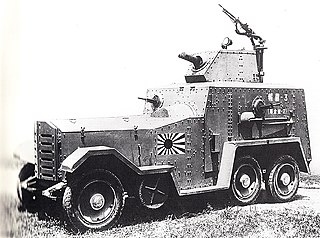
The Type 94 tankette was a tankette used by the Imperial Japanese Army in the Second Sino-Japanese War, at Nomonhan against the Soviet Union, and in World War II. Although tankettes were often used as ammunition tractors, and general infantry support, they were designed for reconnaissance, and not for direct combat. The lightweight Type 94 proved effective in China as the Chinese National Revolutionary Army had only three tank battalions to oppose them, and those tank battalions were equipped only with some British export models and Italian CV-33 tankettes. As with nearly all tankettes built in the 1920s and 1930s, they had thin armor that could be penetrated by .50 caliber (12.7 mm) machine gun fire at 600 yards (550 m) range.

The Type 97 Light armored car Te-Ke was a tankette used by the Imperial Japanese Army in the Second Sino-Japanese War, at Nomonhan against the Soviet Union, and in World War II. It was designed as a fast reconnaissance vehicle, and was a replacement for the earlier Type 94 tankette.

An armoured train or armored train is a railway train protected with heavy metal plating and which often includes railway wagons armed with artillery, machine guns, and autocannons. Some have also had ports used to fire small arms from the inside of the train, especially in earlier armoured trains. For the most part, they were used during the late 19th and early 20th centuries, when they offered an innovative way to quickly move large amounts of firepower into a new location. Most countries have discontinued their use – road vehicles became much more powerful and offered more flexibility, train tracks proved too vulnerable to sabotage and attacks from the air, and air transportation was an even more flexible way to relocate firepower to a new location. However, there have been occasional uses in the late 20th century and early 21st century. The Russian Federation has used improvised armoured trains in the Second Chechen War (1999–2009) and in its invasion of Ukraine (2022–present).

The Special Naval Landing Forces were the marines of the Imperial Japanese Navy (IJN) and were a part of the IJN land forces. They saw extensive service in the Second Sino-Japanese War and in the Pacific theatre of World War II. The SNLF should not be confused with the Naval Landing Forces, which were primarily ad-hoc units of naval personnel formed into naval infantry units whom rarely performed proper amphibious operations and were primarily utilized in a defensive role ashore.

The Type 95 Ha-Gō was a light tank used by the Empire of Japan during the Second Sino-Japanese War, at the Battles of Khalkhin Gol against the Soviet Union, and in the Second World War. It proved sufficient against infantry but was not effective against other tanks. Approximately 2,300 were produced, making it the most numerous Japanese armoured fighting vehicle of the Second World War.

The Marmon–Herrington armoured car was a series of armoured vehicles that were produced in South Africa and adopted by the British Army during World War II. They were also issued to RAF armoured car companies, which seem never to have used them in action, making greater use of Rolls-Royce Armoured Cars and other types.

The Type 92 heavy armoured car, also known as the Type 92 cavalry tank, was the Empire of Japan's first indigenous tankette. Designed for use by the cavalry of the Imperial Japanese Army by Ishikawajima Motorcar Manufacturing Company, the Type 92 was designed for scouting and infantry support. The Type 92 was thin armored and lightly armed. Although actually a light tank, it was called sōkōsha in Japanese due to political sectionalism within the Japanese Army. Exactly the same device was used in America with the M1 Combat Car.

This article deals with the history and development of tanks of the Japanese Army from their first use after World War I, into the interwar period, during World War II, the Cold War and modern era.

The Type 93 armoured car (九三式装甲自動車) was an armoured car used by the Empire of Japan both before and during World War II in China.

The Sumida M.2593 was an armoured car produced by the Empire of Japan in the 1930s. It could operate on both the roadway and railway lines. There were two main versions of the Sumida M.2593 made. The Type 91 armoured railroad car was used by the army and the Sumida Model P armored car was used by the Special Naval Landing Forces (SNLF) of the navy.

The Chiyoda armoured car was the first domestic Japanese armoured car which was officially introduced by the Imperial Japanese Army (IJA) and produced in the 1930s.
The Reconnaissance regiment in the Japanese language was a type of military establishment within the Imperial Japanese Army during the 1940-1945 period. Derived from the Cavalry regiment, the Reconnaissance regiment was tasked with combat scouting. In Japanese military literature, the term reconnaissance regiment is commonly abbreviated as SO. These regiments were often attached to numerous Japanese divisions during the initial stages of the Pacific War. In contemporary Japan, these regiments are analogous to Reconnaissance battalions within the divisions of the Japan Ground Self-Defense Force.












